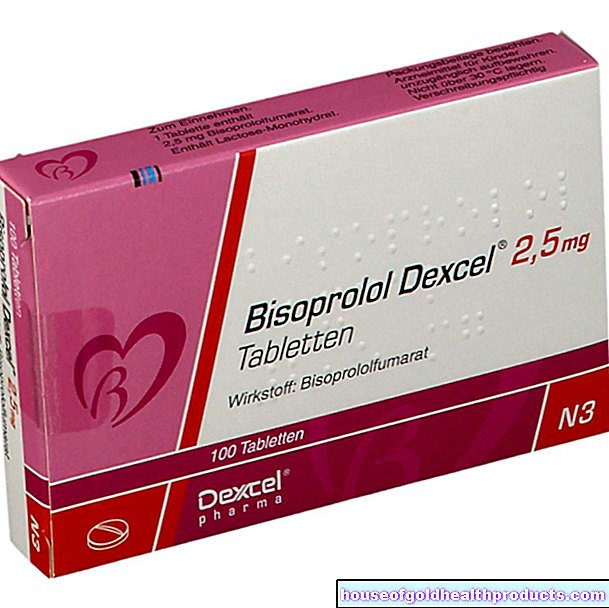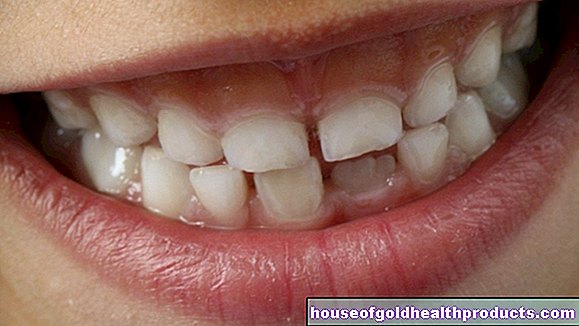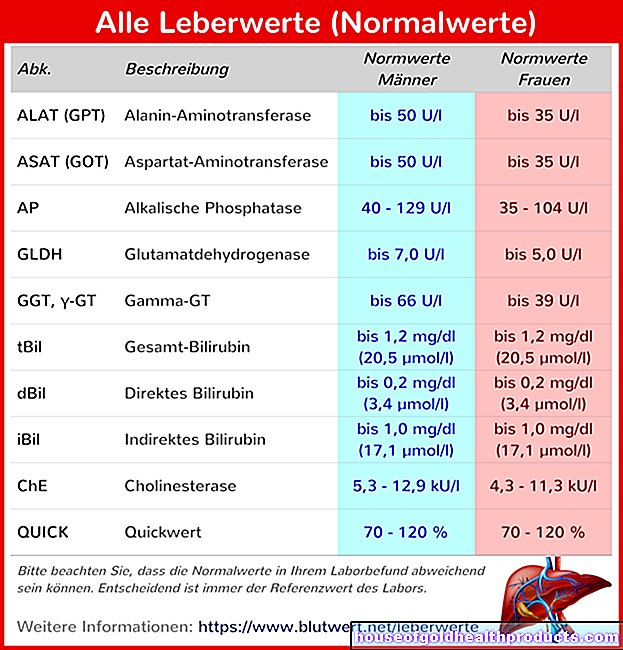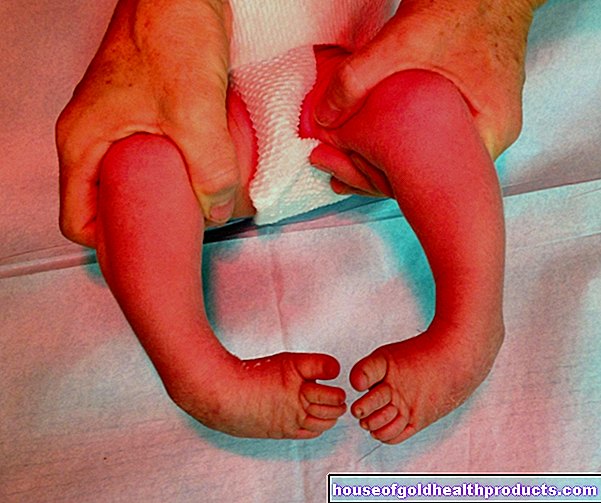Paget's disease
Dr. med. Mira Seidel is a freelance writer for the medical team.
More about the experts All content is checked by medical journalists.Paget's disease (Osteitis deformans, Osteodystrophia deformans) is a disease of the bones: In some places, thickened and deformed bones are formed. The cause of Paget's disease is so far unknown; genetic factors and viral infection could play a role.Since many sufferers show no symptoms at all, the disease is usually discovered late or not at all. Bisphosphonates are suitable drugs for therapy. Find out more about Paget's disease here.
ICD codes for this disease: ICD codes are internationally recognized codes for medical diagnoses. They can be found, for example, in doctor's letters or on certificates of incapacity for work. M88Paget's disease: description
Paget's disease is named after the British surgeon Sir James Paget (1814-1899).
The term is actually a synonym for various clinical pictures: Orthopedists mean by "Paget's disease" the bone disease osteodystrophia deformans. Gynecologists call "Paget's disease of the nipple" a rare form of cancer of the nipple. There is also "Paget's disease of the vulva", a pathological change in tissue in the pubic area. However, only Paget's disease of the bones is treated below.
Paget's disease usually begins after the age of 40 and is the second most common bone disease after osteoporosis. Around one to two percent of people over 40 in Western Europe are affected by the disease. It occurs most frequently in England, but is very rare in Asians and Africans. More men get it than women.
Only about 30 percent of Paget's disease cases are diagnosed during lifetime - so there are a significant number of undiagnosed patients. Only one in 25,000 residents needs therapy.
Paget's disease: symptoms
Only ten percent of those affected by Paget's disease show symptoms such as local pain, while 90 percent are symptom-free. In most cases, the disease is therefore not even diagnosed.
Paget's disease: bone, joint and muscle pain
The decreased bone stability and deformation in Paget's disease lead to painful cracks and fractures in the bones. Those affected complain of bone pain. In addition, the changed bone statics can cause improper strain with muscle tension and persistent muscle pain.
If Paget's disease progresses, deformities develop as a result of bone fractures. Extreme deformations of the affected bones, which are also visible from the outside, can often occur. Typical examples are curved and thus shortened shins ("saber shinbones") or an enlarged head circumference. Often times, their hats no longer fit those affected.
In the adjacent joints, so-called secondary arthrosis can form due to the misalignment: the deformed bones put excessive strain on the joints, which causes them to wear out.
Paget's disease: overheating
Paget's disease boosts bone metabolism. This creates new blood vessels that lead to increased blood flow. The vessels expand and ignite. If the bone is directly under the skin, for example on the shin, the increased blood flow can be felt as overheating.
Paget's disease: nerve compression
The uncontrolled bone formation in Paget's disease can also damage nerves. For example, nerves or even brain tissue can become compressed as the skull increases in size.
Paget's disease: hearing loss
If nerves in the area of the skull are affected, hearing loss occurs in 30 to 50 percent of cases. This is due to impaired sound sensation and, more rarely, sound conduction disorders, which can be traced back to bony joint bridges in the ossicles or compression of the auditory nerves.
Paget's disease: malignant tumors
Malignant tumors develop in less than one percent of Paget's disease patients with symptoms. An osteosarcoma - a malignant bone tumor that is popularly known as bone cancer - develops on the bones affected by the disease. The pelvic, thigh and humerus bones are particularly affected. Affected patients notice that the symptoms suddenly worsen and the deformation of the bone increases. An increase in alkaline phosphatase (a liver enzyme) can be detected in the blood.
Paget's disease: causes and risk factors
Bones are not static structures, but are constantly being remodeled. Two different cell types are primarily involved in this: osteoclasts break down bone substance, while osteoblasts build them up again. In a healthy person, this process takes place in a coordinated manner - bone formation and breakdown are in balance.
Paget's disease: imbalance
In contrast to healthy bones, the process of building and breaking bones in Paget's disease does not take place uniformly and in a coordinated manner, but without any system and regionally different. Pathologically altered osteoclasts are to blame for this. So-called giant osteoclasts are found on the changed bone areas - they have up to a hundred cell nuclei, while a normal osteoclast only has three to 20 cell nuclei. These osteoclasts are significantly more active than the healthy variants and therefore break down more bone substance.
In response, Paget's disease patients' bodies try to make new bone material. Zones with firmer bones are next to those with a reduced content of calcium carbonate. The bone changes its shape, appears swollen, thickened or deformed or breaks more quickly in places with a reduced calcium content. The remodeling processes particularly affect bones that are heavily used. These include the pelvis (in about two thirds of Paget's disease sufferers), thighs, shins, skull bones (due to the chewing activity) and lumbar spine.
It is not exactly known why these giant osteoclasts form in Paget's disease. It is believed that a genetic predisposition plays a role in this. Experts also discuss whether an infection with certain viruses (slow virus infection) is involved in the development of Paget's disease. With the electron microscope, you can find inclusions in the cell nuclei of the giant osteoclasts that are reminiscent of viruses. These inclusions are only found in Paget's disease osteoclasts, but not in any other bone cells.
Paget's disease: examinations and diagnosis
People with Paget's disease do not always see a doctor about their symptoms. The disease is often discovered by chance, for example through changes in blood values or in an X-ray. The right person to contact if you suspect Paget's disease is a specialist in internal medicine and endocrinology. However, you can first go to your family doctor, who can arrange for further examinations if necessary.
Paget's disease: medical history
First, the doctor will take the medical history (anamnesis). Because based on the symptoms that the person concerned describes, the doctor can roughly estimate whether Paget's disease is a possible cause. He may ask the following questions when taking the medical history:
- Do you have pain? Where does this pain occur?
- Is the pain localized in a specific area, for example the back, head or joints?
- How long has this pain been there?
- Have you noticed an increased skin temperature over the affected areas?
- Has your head size changed or increased? Do you still fit your hat?
- Do you have any other complaints such as paralysis, impaired sensation, vision or hearing?
Paget's disease: physical examination
After taking your medical history, the doctor will examine you briefly. He carefully scans the affected areas in order to get an impression of the intensity of the pain. He will also check whether there are incorrect postures such as deformities, contractures or shortening. In a side comparison (right and left side of the body) the doctor can see whether muscle mass has receded. He will also ask you to walk in a line to see if your gait is fluid or limping. He will also carry out some functional tests of the joints and the range of motion.
A few neurological exams may also be needed to test if the spinal canal is narrowed or the spinal cord is compressed.
Paget's disease: laboratory examination
A blood test usually shows an increased level of the enzyme alkaline phosphatase (AP) in people with Paget's disease. This is an indication of an increased activity of the osteoblasts, i.e. the cells that build up bone.
The activity of osteoclasts, the cells that break down bone, can also be determined by measuring the amount of the amino acid hydroxyproline in the urine.
Paget's disease: X-ray
An X-ray examination is necessary to reliably diagnose Paget's disease. As a rule, it is only performed on the bony areas with discomfort. The course of Paget's disease is divided into three phases, which are visible on X-rays. However, they can also be detectable in one patient at the same time:
- In the first phase, bone loss is visible (osteolysis).
- In the second and most common phase, a mixed picture of areas with bone loss and areas with hardened bone material is visible (osteosclerosis).
- In the third phase, predominantly hardening with swellings and deformations of the affected bones can be seen. The trabecular system (cancellous bone) is coarsened and interspersed with individual bone dissolving foci.
Paget's disease: scintigraphy
To look for other bone lesions, a bone scintigraphy is performed - a nuclear medicine examination that can detect up to 50 percent more affected bone areas than an X-ray examination. A radioactively labeled substance is administered into the bloodstream of the patient. The substance is deposited in the bone, especially where it has a high metabolic activity and is particularly well supplied with blood. In a subsequent X-ray, the accumulation of the substance in the bone and thus areas with increased bone remodeling can be demonstrated.
Paget's disease: computed tomography or magnetic resonance tomography
Depending on the medical history and the results of the physical examination and the laboratory tests, further technical examinations will follow. Computed tomography (CT) or magnetic resonance imaging (MRI) can be used to clarify whether the spine is affected by Paget's disease.
Paget's disease: bone biopsy
The diagnosis of "Paget's disease" can usually be made unambiguously due to the typical changes in the X-ray image and the abnormal laboratory values. In cases of doubt, however, a bone biopsy (removal and examination of a tissue sample from affected bones) can be performed to confirm the diagnosis. In addition, other bone diseases can be differentiated from Paget's disease and a possible malignant bone tumor can be excluded.
Paget's disease: treatment
The goals of Paget's disease treatment are on the one hand pain relief and on the other hand stopping bone remodeling and thus the spread of Paget's disease. In order to achieve these goals, bisphosphonates are used as the drug of choice in the drug therapy of Paget's disease. In some cases, calcitonin is also given. Both groups of active ingredients inhibit the increased bone metabolism and thus above all the excessive breakdown of bone by the osteoclasts. Deformities and fractures of the bones can thus be avoided. In addition, other therapeutic measures are used for Paget's disease.
Paget's disease: bisphosphonates
Bisphosphonates are taken either as oral medications (such as risedronic acid) or given as infusions (such as pamidronic acid and zoledronic acid).
In tablet form, however, the intestine absorbs the active ingredients poorly. Therefore, they must be taken on an empty stomach with a large glass of water. In order not to hinder absorption in the intestine, you should not eat anything for about an hour afterwards. About two to ten percent of patients with Paget's disease experience side effects such as nausea, abdominal pain, vomiting, or diarrhea after oral use of bisphosphonates. This can be prevented if bisphosphonates are given as an infusion.
Treatment of Paget's disease with bisphosphonates takes place in cycles. The tablets are taken daily or once a week for a period of two to six months. The infusion time is between 15 minutes and four hours, depending on the substance. The infusions are given either at intervals of four weeks to three months or as a short infusion once a year. The latter applies to the bisphosphonate zoledronate.
Paget's disease: calcitonin
Alternatively, Paget's disease can be treated with the hormone calcitonin, which also inhibits the activity of the osteoclasts. However, it appears to be less effective than bisphosite.
Patients receive calcitonin either in the form of a syringe or through the nose using a nasal spray. Oral use is not possible as the stomach acid would destroy the hormone. In a relatively large number of patients, calcitonin leads to side effects and intolerance reactions, primarily to reddening of the skin, but also to nausea and vomiting.
Paget's disease: pain management and surgical therapy
If patients with Paget's disease suffer from persistent pain, increasing bone deformations, fractures and secondary arthrosis, especially in the legs, pain medication and surgical treatment may be necessary.
Paracetamol is the first choice for drug pain therapy. Symptoms can also be alleviated with physical measures such as physiotherapy, massage, electrical and balneotherapy and local injections. The application of heat is not recommended because the bones of Paget's disease are already overheated.
In the case of thigh fractures and advanced osteoarthritis of the hip and knee joints, an operation can be useful. If neurological symptoms such as paralysis or gait disorders occur due to nerve compression as a result of bone deformation in the area of the spinal canal, an operation must be performed on the spine.
Paget's disease: other therapeutic measures
A sufficient intake of calcium and vitamin D should also be ensured, as they play an important role in bone metabolism. Calcium should be taken with bisphosphonates at a time interval of two hours, otherwise their absorption will deteriorate.
Paget's disease: disease course and prognosis
Patients with Paget's disease have an increased risk of developing a malignant bone tumor (osteosarcoma). Regular medical check-ups are therefore a must for Paget's disease. As a follow-up, the blood level of alkaline phosphatase (AP) should be determined three months after the start of therapy and then every six months. If pain occurs again, X-raying should be carried out again, if necessary, in order to rule out other possible diseases.
The prognosis for Paget's disease is good, but it also depends on how severe the disease is. In some patients, only a limited area of the bones is affected. Bone cancer (Paget's sarcoma) develops in about one percent of cases. In this case, surgery is required as early as possible.
Despite the more or less severe physical limitations, life expectancy with Paget's disease is usually not shortened.
Tags: laboratory values prevention skin care
.jpg)




























